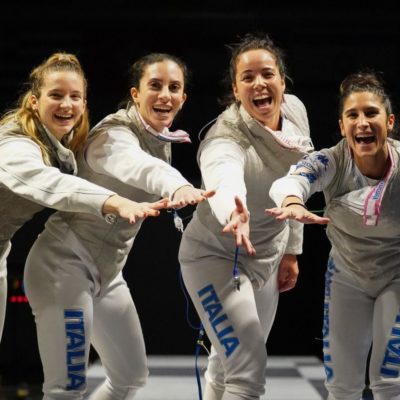These are the people in your neighborhood…
{mosimage}When a fencer climbs the podium to receive their medal, they are not just representing themselves. They’re representing the team of people who worked together to get them there.
Rather like the army, where each frontline soldier is backed by up to a dozen support soldiers, getting a fencer to a tournament is a community effort. As the tired saying goes, it takes a village. Here are some of the major players in the creation of a fencer.
{mosimage}Parents, family and friends.
Obviously, young fencers wouldn’t be able to get to practice without carpooling, much less buy the equipment they need. But even mature athletes will find it difficult to make time for practice, and overcome the psychological rigors of competition, without a good support network.
Fencers — indeed, all competitors — need interested and invested parties to give them the security they need to take risks. Essentially, competitors need people who will be let down if they don’t perform to their abilities. Results must matter, and not just to the fencer.
Equipment vendors
Everybody loves to complain about their equipment… the price, the quality. However, these overworked, under-appreciated capitalists could have built their businesses around a much more profitable industry.
Because they grew up in (or were adopted into) the fencing world, they are fencing’s greatest unacknowledged boosters. Operating on slim margins in a cut-throat market, their goal (and financial well-being) revolves around building the sport as quickly as possible. It’s not easy to keep up with the fast-changing rules for equipment, but they do — and they’ll give discounts to clubs and bulk purchases for children. After all, more fencers mean more business.
Armorer
Fencing equipment doesn’t fix itself. It often requires the ministrations (and good-natured rebukes) of the armorer. More than just glorified handymen, armorers are expected to have answers for everything. It’s not easy getting space-age fencing technology to operate smoothly, especially when it’s been abused by fencers all day.
Every piece of combat lore in fencing is balanced by an equal piece of armoring knowledge. What kind of glue is best to repair fencing shoes? What is the best way to test an electric weapon? Can dents be safely hammered out of masks? Only the armorer knows.
{mosimage}
Teammates
Nobody understands the rigors of training, losing, training, winning and training better than the people sweating alongside a fencer. Having teammates around, constantly trying to beat their peers, spurs athletes to always do better. Training routines seem to move faster, strategy seems to makes more sense, and sparring seems more fun with a group of dedicated, like-minded fencers.
At tournaments, good, reliable teammates are essential. Whether they’re cheering from the sidelines, tossing you a bottle of water during a time-out, or whispering advice on how to beat an opponent, every successful competitor needs them. And, to have good teammates, you need to be a good teammate.
Coach
The parents, friends, equipment vendors, armorers and teammates all work together to create a good student for the coach. The coach takes an athlete and shapes them into a fencer.
By putting them through long, rigorous one-on-one lessons, the coach creates a testing and seasoning process not unlike the forging of a sword blade. Heat the metal up and then pound it into a new shape — all the while preserving the inherent temper which makes it strong. The process is destructive, so that it may be instructive. And the result is a finely honed fencer, trained to a peak, and ready to win.
The opponent
Yes, it’s true. At the end of the long road, the final party necessary for building a fencer is the other fencer. No fencer would get this far in the process unless they had something to prove — to themselves and the world. And you can’t prove yourself in a combat sport without having the opponent facing you, slavering for your blood.
Unlike some other sports, it’s not easy in fencing to forget the value of your opponent. Any slip-up on your part is met with a solid thump on the chest and an animal scream, and a crowd cheering against you. This is why, even at the highest Olympian levels of the sport, fencers salute each other, shake hands, acknowledge points, and even embrace after the final point is scored.
{mosimage} The last puzzle piece…
It’s a long list, and for the most part, these are the people in your neighborhood. Each fencer is the product of their environment, which is why it is crucial for clubs to have a good fencing culture.
The final ingredient in this mix is, of course, the fencers themselves. The fencer must be willing to subject themselves to long hours of training away from friends and family. They must be willing to travel to every tournament they can possibly compete in. And, when they win, must remember to credit everybody who helped them get there.
Photo credits:
- Photo 1 by: Evan Whitney. Trophies on display at the 2003 IFA’s.
- Photo 2 courtesy of http://www.escrime-info.com. Teammates at Les Cadettes à Jena tournament.
- Photo 3 by: Evan Whitney. Brown’s Lucy Walker ’06 shares a word with teammate John Wurzel ’04.
- Photo 4 by: Evan Whitney. Brown fencers Sophie Klein ’03, John Wurzel ’05, Paul Friedman ’03 and Jason Sobel ’02 cheer on their teammates.





